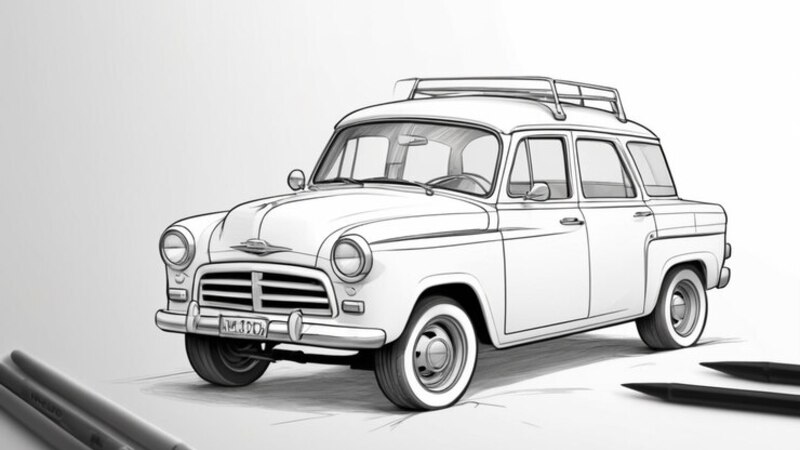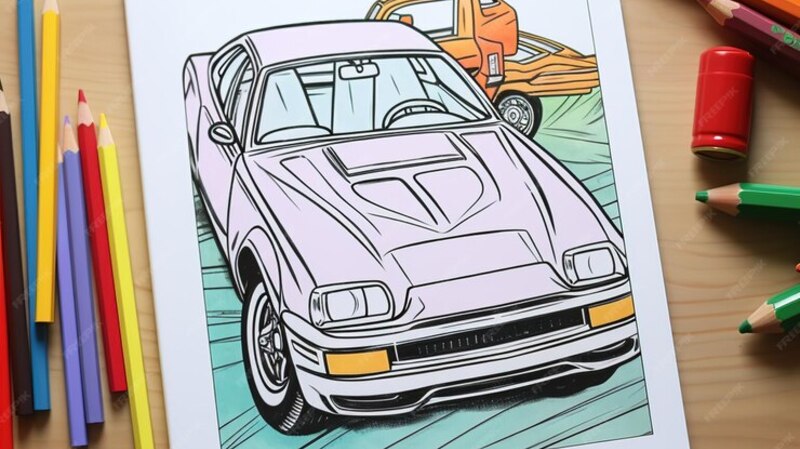Drawing cars is a fascinating pursuit that combines technical precision with artistic creativity. Whether you’re an aspiring automotive designer, a car enthusiast, or just someone who loves to draw, understanding how to create accurate and dynamic car drawings is an essential skill. This article will guide you through the process of mastering drawing:burmhcczepe= car by covering the tools, techniques, and best practices that can help you create stunning car illustrations. We will explore the different stages of car drawing, from basic shapes to complex details, and offer tips to refine your skills.
Why Learn drawing:burmhcczepe= car?
Cars have been a symbol of innovation, freedom, and style for over a century. For artists, drawing cars is not just about replicating a vehicle’s appearance; it’s about capturing the essence of movement, design, and engineering. “drawing= car” can be a rewarding way to enhance your overall drawing skills, improve your attention to detail, and understand the intricacies of automotive design.
The Importance of Perspective in Car Drawing
One of the key challenges in drawing:burmhcczepe= car images is mastering perspective. Cars are three-dimensional objects, and capturing their form accurately on a two-dimensional surface requires a solid understanding of perspective. Perspective helps in conveying depth, proportion, and the overall structure of the car, making the drawing more realistic and convincing.
Tools and Materials for drawing:burmhcczepe= car images
Before diving into the techniques of drawing:burmhcczepe= car picture it’s important to have the right tools and materials. Here are some essentials:
1. Pencils
- Graphite Pencils: Ranging from H (hard) to B (soft), graphite pencils are the most versatile tools for car drawing. Use harder pencils for precise lines and softer ones for shading.
- Mechanical Pencils: Great for fine details, mechanical pencils provide consistent line width.
2. Paper
- Sketch Pads: Choose smooth paper for detailed car drawings, as it allows pencils to glide smoothly, making it easier to create clean lines.
- Bristol Board: This is ideal for more refined work, offering a sturdy surface that holds up well to erasing and reworking.
3. Erasers
- Kneaded Eraser: Perfect for lifting graphite without damaging the paper, it’s useful for lightening areas or correcting mistakes.
- Vinyl Eraser: Use this for complete erasure of pencil marks, especially in areas where you need to remove strong lines.
4. Rulers and French Curves
- Rulers: Essential for drawing straight lines, especially in the initial stages of “drawing = car” when laying out the basic structure.
- French Curves: These are great for drawing smooth, consistent curves, particularly useful in car designs with flowing lines.
5. Digital Tools (Optional)
For those interested in digital car drawing, tools like tablets (Wacom or iPad Pro) and software (Photoshop, Illustrator, or Procreate) can be incredibly effective. Digital tools offer the flexibility to experiment with colours, and layers, and undo mistakes quickly.
Step-by-Step Guide to drawing:burmhcczepe= car pictures
1. Understanding Car Proportions
The first step in the drawing:burmhcczepe= car picture is to understand the proportions of the vehicle. Cars have a distinctive shape, with specific ratios between the wheels, body, and windows. Here’s a basic guideline:
- Wheelbase: The distance between the front and rear wheels is crucial. It determines the overall length and stance of the car.
- Height and Width: The height of the car from the ground to the roof and the width from one side to the other should be proportionate to the wheelbase.
- Wheel Size: Typically, the wheels should occupy about one-fifth to one-sixth of the car’s height.
Begin by sketching the basic outline of the car using simple shapes. Draw a rectangle for the body, circles for the wheels, and lines for the roof and windows. This rough sketch will serve as the foundation for more detailed work.
2. Sketching the Basic Structure
With the proportions in place, you can start refining the shapes into more recognizable forms. For drawing:burmhcczepe= car images follow these steps:
- Outline the Car Body: Start with the main body of the car. Use long, smooth lines to define the shape, paying attention to the curves and angles that make the car unique.
- Add the Wheels: Draw the wheels as perfect circles or ellipses, depending on the angle of the car. Ensure they are evenly spaced and aligned with the body.
- Refine the Roofline: Sketch the roof, windshield, and windows, adjusting the lines to fit the perspective. The roofline should smoothly transition into the body, with the windows and windshield fitting proportionately.
3. Adding Details to “drawing= car”
Once the basic structure is established, it’s time to add details that will bring your car drawing to life:
- Headlights and Grille: Draw the headlights and grille with precision. These elements often define the character of the car. Use a ruler for straight lines and pay attention to symmetry.
- Windows and Mirrors: Outline the windows, making sure they follow the contour of the car’s body. Add side mirrors, considering their position relative to the windows.
- Door Handles and Trims: These small details are essential for realism. Sketch door handles, trims, and other features with light strokes, refining them gradually.
4. Shading and Texturing
Shading adds depth and dimension to your “drawing= car,” making it appear more realistic. Here’s how to approach shading:
- Identify Light Source: Determine the direction of the light source. This will guide where you add shadows and highlights.
- Shade the Body: Use softer pencils (B grades) to shade areas away from the light source. Gradually build up the shading to create smooth transitions between light and dark areas.
- Detail the Wheels: Add shading to the wheels, focusing on the areas under the car and where the tyres meet the ground. Highlight the rims and treads for added realism.
- Reflections on Windows: Windows often reflect the surroundings. Use light, horizontal strokes to suggest reflections, and darken the edges to emphasize depth.

Read More: https://how2invest.work/a-comprehensive-guide-to-drawingwi2u7v_j0iq-hello-kitty/
5. Final Touches and Refinement
The final stage of drawing:burmhcczepe= car photos involves refining the details and cleaning up the drawing:
- Enhance Key Details: Go over important lines, such as the edges of the car, the grille, and the headlights, with a sharper pencil or ink for a crisp finish.
- Smooth Out Shading: Use a blending stump or tissue to smooth out the shading, creating a more polished look.
- Correct and Clean: Erase any unwanted lines and smudges. Make sure the final drawing is clean and clear, with all elements correctly proportioned and aligned.
Exploring Different Styles in Drawing:burmhcczepe= car pic
Realistic Car Drawing
Realism is about capturing the car as accurately as possible, with attention to detail, proportion, and shading. This style requires patience and a good eye for detail, as you aim to replicate the car’s appearance in every aspect.
Cartoon and Exaggerated Styles
For a more playful approach, consider drawing cars in a cartoon or exaggerated style. This involves stretching the proportions, emphasizing certain features (like oversized wheels or a sleek, streamlined body), and using bold lines and colours. “drawing= car” in this style can be a fun exercise in creativity, allowing you to explore the more imaginative aspects of automotive design.
Technical and Blueprint Drawing
Technical drawing is all about precision. It involves creating detailed, scaled diagrams of the car, often used in design and engineering. This style requires exact measurements and a clear understanding of perspective, making it a more challenging but rewarding approach to drawing:burmhcczepe= car pics
Common Challenges in drawing:burmhcczepe= car photo and How to Overcome Them
1. Getting the Proportions Right
One of the biggest challenges in drawing:burmhcczepe= car image is getting the proportions correct. This can be tricky, especially when working with perspective. To overcome this, practice drawing cars from different angles and use reference images to guide your proportions. Starting with a grid can also help maintain consistency in size and placement.
2. Capturing Curved Surfaces
Cars often have curved surfaces that can be difficult to capture on a flat piece of paper. To master this, study how light interacts with curved surfaces. Use shading techniques to suggest curvature, and practice drawing simple objects like cylinders and spheres to improve your understanding.
3. Achieving Realistic Shading
Shading can make or break a car drawing. To achieve realistic shading, focus on creating smooth transitions between light and dark areas. Practice blending techniques and experiment with different pencils to find the right balance of contrast and texture.
4. Dealing with Complex Details
Cars have numerous intricate details, from the grille to the wheels. It’s easy to get overwhelmed, but the key is to take it one step at a time. Break down the drawing into sections and focus on completing one detail before moving on to the next. Use reference images to guide you, and don’t be afraid to simplify certain elements if necessary.
The Role of Practice in Drawing:burmhcczepe= car images
Like any skill, mastering drawing:burmhcczepe= car pic requires consistent practice. Set aside time each day to draw, experiment with different styles, and challenge yourself with new techniques. Over time, you’ll notice improvements in your ability to capture the proportions, details, and overall essence of cars.
Building a Portfolio
As you practice, consider building a portfolio of your car drawings. This will not only track your progress but also serve as a valuable resource if you decide to pursue automotive design or illustration professionally. Include a variety of styles, perspectives, and techniques to showcase your versatility.
Seeking Feedback
Don’t hesitate to seek feedback on your work. Join online communities, share your drawings on social media, or ask for critiques from more experienced artists. Constructive criticism can provide valuable insights and help you refine your skills.
The Future of drawing:burmhcczepe= car pictures

Read More: https://how2invest.work/drawingnl2qdfgosl0-ghostface-the-ultimate-guide/
As technology advances, so do the tools and techniques available for drawing:burmhcczepe= car photos Digital drawing platforms continue to evolve, offering more sophisticated tools for rendering, colouring, and creating 3D models. However, the fundamentals of drawing—proportion, perspective, and attention to detail—remain as important as ever.
Digital vs. Traditional Drawing
While digital drawing offers many advantages, such as easy editing and access to a wide range of tools, traditional drawing has its own merits. Working with pencils and paper can provide a deeper understanding of technique and a more tactile connection to your work. Many artists find that combining both methods allows them to take full advantage of each medium’s strengths.
Incorporating Technology
Even if you prefer traditional drawing methods, incorporating technology can enhance your work. For example, you can use digital tools to experiment with colour schemes, create mock-ups, or add digital effects to your pencil drawings. The possibilities are endless, and blending traditional and digital techniques can lead to innovative results.
Conclusion
Mastering drawing:burmhcczepe= car photo is a journey that combines artistic creativity with technical skill. By understanding the fundamentals of proportion, perspective, and shading, and by consistently practising and seeking feedback, you can develop the ability to create stunning and accurate car drawings. Whether you pursue this art form as a hobby or a profession, the skills you acquire will serve as a foundation for all your future artistic endeavours.
Read More; https://how2invest.work/wheelheap-site-the-ultimate-guide-to-maximizing-its-potential/
